It feels as though the list of outstanding tasks is getting longer rather than shorter. So they have been prioritised into those required for the MOT and those that can wait. Due to the age of the car the MOT is essentially limited to checking the suspension, fuel/brake lines and lights. However, knowing the person doing the MOT, I’d asked them if they would cast a more critical eye over the whole car.
I’d been having trouble balancing the carbs and, although it’s not part of the MOT, I thought it best to have a second pair of eyes look over them. The front two cylinders are running too lean, even though all three carbs have been set to the standard reference point for tuning. So it will be tuned and the headlights aligned beforehand.
I also have concerns about the fuel flow. Last year the petrol tank had be put in-situ to just to start the engine for the first time. The tank was then removed to be painted and since then I noticed that the fuel flow seems to be rather low. Although I suspect I just hadn’t noticed the problem before.
| Testing fuel flow from pump |
Comparing the fuel flows per minute:
250ml at front bulkhead in bottle,
2litres at rear bulkhead in jug |
 |
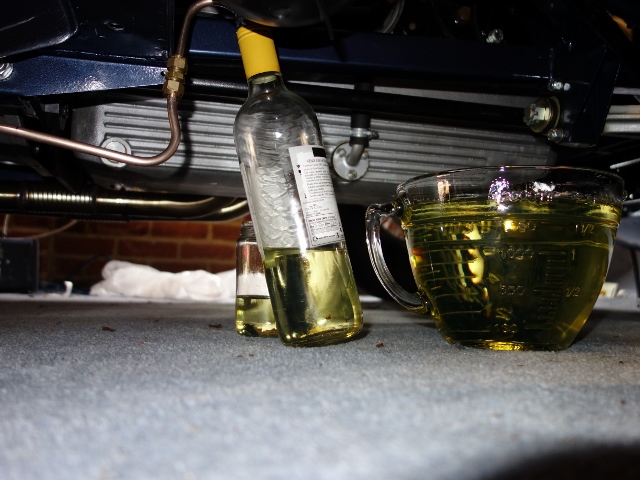 |
The measurements of the amount of fuel pumped in one minute was taken at the rear bulkhead union and then at the other end of the pipe at the union on the front bulkhead. Although it’s not really a valid test, as there wouldn’t be any back pressure at the rear union, it did provide a feel for the drop off in flow – 2 litres per minute measured at the rear bulkhead union and only 250ml per minute at the front bulkhead union.
Suspicion is that it may be due to an air-lock created in the pipes. However advice from the forum suggested that a pump in good working order would have more than enough ummph to purge any air locks. Some further checks will be done to get to the bottom of the problem.
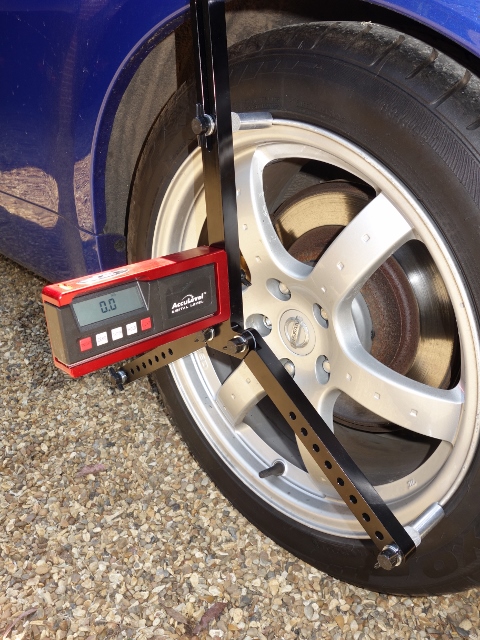
Longacre Camber/Castor Tool
The intention was to set up the suspension geometry myself and so I’d purchased a Longacre electronic camber/castor tool and a Trackace tool for the wheel alignment. The camber/castor tool has three legs which rest against the wheel rim with an accurate inclinometer attached in the centre. However I wasn’t thinking things through and had completely overlooked needing clearance for the central spinners.
The prongs on the legs don’t have the reach so I’ll have to have some made up. Unfortunately the MOT centre no longer has accurate electronic measuring tools for suspension set up. This will have to wait until after the MOT.
For some reason one of the dash indicator tell-tale lights had stopped working and the fault traced to the switches in the indicator stalk. It was easier to take the whole steering column off and investigate further on the bench. A loose back-plate on the switch mechanism had allowed the indicator contact to move about and be bent out of shape. So it was easily rectified.
The clamping bolts on the upper and lower steering column’s UJs had been taken off to aid the removal of the upper column. However, I’d become side-tracked and had not refitted them before attempting to tick off another pre-MOT task … making sure the speedo drive was working.
Needless to say, as I was turning round, after completing a successful straight 40 yard speedo run up the drive, the lower column dropped out of its splines. All steering was lost, blocking a now busy communal drive!
Apart from being stupid, it was a rather timely reminder! The complete suspension parts list was used as a check sheet to ensure every suspension nut and bolt was revisited to make sure everything was correctly torqued.
Mudguards, shields and undertrays
The various mudguards, shields and undertrays aren’t strictly necessary for the MOT. However they were fitted, as the horn relay needs to be mounted on the LH mudguard. John Farrell had produced a good guide to the locations and orientations of the five different types of brackets:
| Front frame bracket locations |
Five different bracket sizes |
 |
 |
The first to be installed was the air in-take shield which is attached to bracket A at the top and B at the bottom. The leading face is also bolted directly to the frame. It’s worth noting that bracket E for the floor undertray needs to be put in place around the frame before the shield is attached. In fact it’s worth putting all the brackets in place before attaching any of the mudguards, shields and undertrays.
| A & B brackets for air intake shield |
Bracket E for undertray is fitted
before in-take shield! |
 |
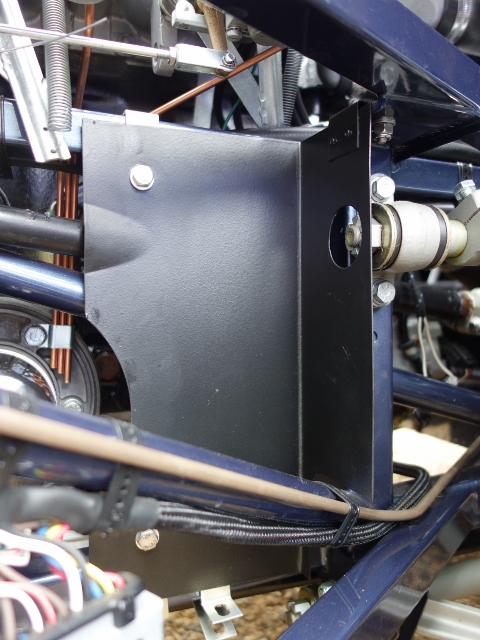 |
The bracket attachments to the frames are identical on both sides of the car, with the obvious exception of the air in-take shield. The torsion bar shields are attached by three brackets – the rear two have the tab with the bolt holes pointing upwards while the front one points downward. Note: the middle bracket on the LH frame is also used to secure the bottom of the exhaust heat shield.
Alternate rear torsion bar shield
& undertray brackets |
Shield bracket also attaches bottom
edge of exhaust heat shield |
Front torsion bar bracket (L)
and mudguard bracket (R) |
 |
 |
 |
The two floor undertrays are simply bolted in place. Although the right hand undertray has a cut out with a separate cover to provide access to the oil filter.
| Left hand undertray |
Right hand undertray,
without oil filter access panel |
 |
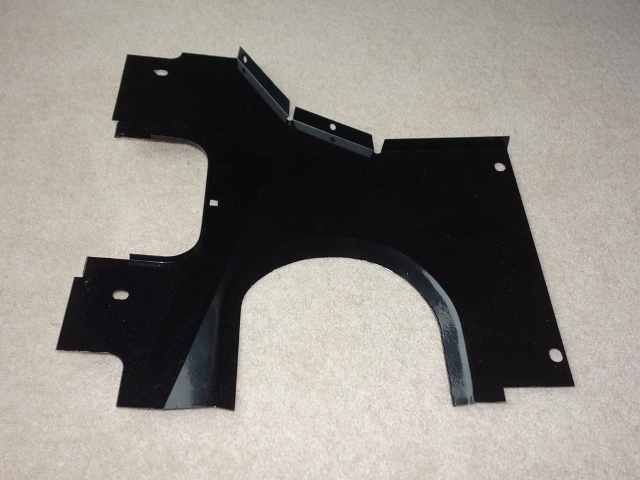 |
There wasn’t any point in completing the fitting the mudguards because they will have to be removed to provide access to set the camber and castor. So at this stage they were only bolted to the sill end panel and attached at the front to a side frame bracket. At least this allowed the horn relay to secured for the MOT. Normally the alternator and aircon (when fitted) relays would also be attached to the LH mudguard, but by modifying the alternator it no longer requires a relay.
| LH mudguard temporarily in place just for the MOT |
Location of horn relay. Alternator relay isn’t needed |
 |
 |
Air Filter
I was regretting not trial fitting the air filter earlier. The new fuel pipe I’d made protruded too far from the face of the toe box, hitting the air filter. Fortunately it was possible to remove a short length from the filter end which resolved the fitting problem but re-introduced all the air bubbles causing the air locks.
It took a while to work out the best method of fitting the air filter element, canister lid and air plenum. Once the canister lid and rubber grommet are in place, there wasn’t sufficient access to pull the grommet up around the lip of the plenum chamber. Eventually I found the best solution was to connect these components off the car and then fit and remove as a single unit.
| Filter canister was hitting the fuel pipe |
Adjusted fuel pipe now narrowly misses it |
Fitting canister lid first didn’t work |
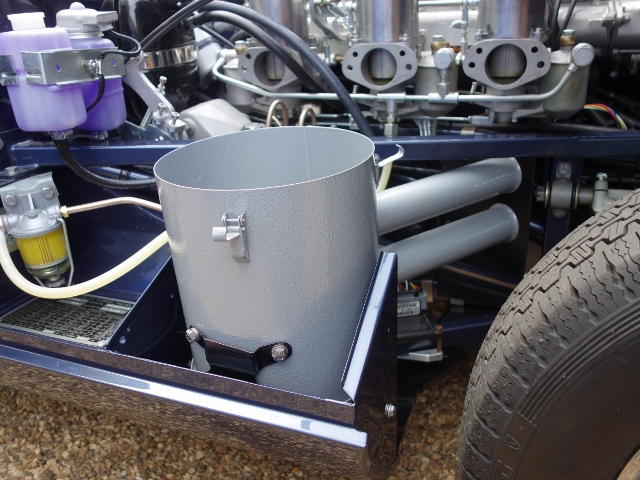 |
 |
 |
Alternator testing
Another task was to ensure the alternator was charging properly when the engine was running at higher revs. The outcome wasn’t as I’d hoped – it wasn’t charging at all, measuring only 12.5 volts! The converted alternator is now self-energising – the AL terminal, normally used for monitoring the alternator output via the ignition warning light, now provides a DC supply to power the field coil. Finding earth via the field coil through the 4TR voltage regulator.
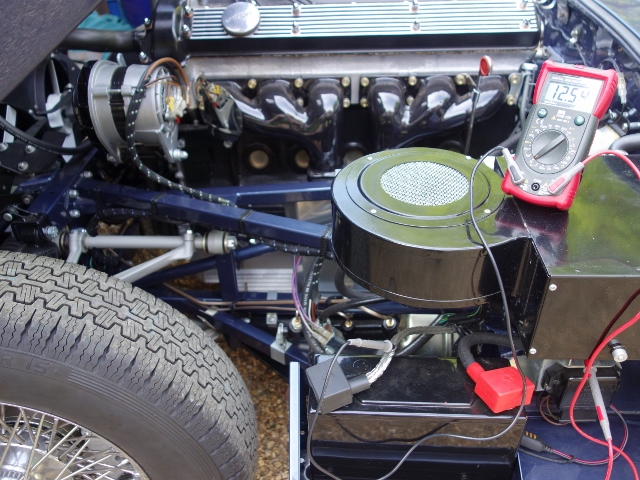
Testing the alternator
The AL terminal was reading zero voltages at idle rather than the expected 14.3 volts! The voltage regulator controls the alternators output to avoid ‘run-away’ where its output would continue increasing until it burnt out the various internal components and/or windings. Increasing the voltage across the field coil increases the alternator output voltage, which in turn increases the field coil voltage.
The 4TR regulator acts as a fast-acting on/off switch. When the output of the alternator increases above a determined voltage (around 14.6v), the regulator switches off the current flowing in the field coil and therefore the alternator voltage drops. Once it has dropped sufficiently, it switches the current in the field coil back on and the alternator output starts to increase, until the cycle repeats.

A passing peacock offered
no helpful advice!!
Suspicion fell naturally on my modifications to the alternator and also the 4TR regulator, which are known to be fragile. A faulty voltage regulator can easily be identified by removing it and using a jumper lead to connect the F and ‘-‘ leads in its connector.
If it is faulty, starting the engine will cause it to start charging (indicated by the alternator output voltage or the battery gauge rising above the battery’s normal 12.3-4 volts) If so, the engine should be switched off immediately and the 4TR unit replaced. It was a great relief to find it was the 4TR unit that was at fault and not my handiwork! A replacement was ordered which confirmed the diagnosis and it is now working as expected.
Crossing fingers
I didn’t want to drill holes in the bodywork for side mirrors and so some clamp on mirrors have been attached to the window frames. That just about completed all the pre-MOT jobs.
| Clamp on side mirrors fitted |
After all this time, it’s finally ready for the MOT!! |
 |
 |
For the first time in several decades, 1R1421 hit the road …… on it’s way to the MOT centre! …. fingers firmly crossed!!




























